
Banners, large and small, sometimes called flags, were widely used by friendly societies, as well as other associations and groups of primarily working people during the 19th and 20th centuries. Many have survived into the 21st century, but are now in need of much loving care and attention to restore them to their original condition. Exemplary collections of banners of all types can be seen at the People’s History Museum, Manchester, and the People’s Story Museum, Edinburgh.
What’s special about OUR collection of AOF banners and related material?
| > | Original research, using contemporary information contained in our Archive, enables us to give otherwise unknown contextual information about our banners; |
| > | All our banners are, or will be, viewable on our website; |
| > | Our archive material has the potential to reveal the widespread use of friendly society banners in local communities during the 19th century. |
Subject Headings Banners |
Further Reading Banner Bright, John Gorman (1986) Raise the Banners High, compiled by Helen Clark (2001) |
 |
 |
 |
 |
 |
 |
 |
 |
 |
 |
 |
Court No. 6110 Banner - Front Court “Industry”, No. 6110 of the AOF was established at Hatfield in Hertfordshire in 1875. Members originally met at the Gun Inn, New Town. A constituent member of the St Albans District of the AOF, the Court grew rapidly in strength and, at the turn of the century, had 538 members. The Court continues (2007) to be in existence as a branch of the Foresters Friendly Society Ltd. The front side of the banner shown here bears the name and number of the Court and its home town. In the centre, the Order’s coat of arms is painted with two male Forester supporters. Beneath these is a smaller tableau depicting the biblical parable of the Good Samaritan, and the Order’s motto in latin, which translated means Unity, Benevolence and Concord. The condition of the central painted image is very good, whilst the quality of the silk surround is excellent. |
|
| Back to Top | ||
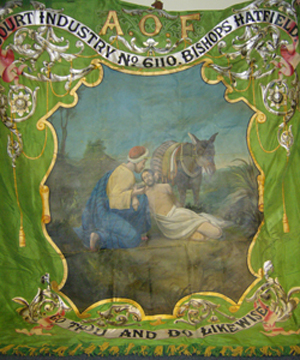 |
Court No.6110 Banner - Reverse
On this, the reverse of the Court’s banner, there is a large scale painted illustration on silk of the biblical parable of the Good Samaritan, in what seems to have been a classical grouping including a donkey or mule. The intimate image conveys the culture of caring for others exemplified in friendly societies. To this is added at the bottom of the banner, the admonition ‘Go thou and do likewise’. As with the front, the reverse is in outstandingly good condition, given its age, and has evidently been well cared for. Neither side of the banner contains the name of the manufacturer. The best guess for a date of manufacture suggests the last quarter of the 19th century.
|
|
| Back to Top | ||
 |
Court No.2585 Banner - Front
The front side shows the two male Forester supporters, alongside one of which is a lion, and these are flanking the Order coat of arms. Above the painted area are Court details. The condition and quality of the painted images are probably not of the same standard as when originally painted, having a faded appearance. The silk area is in very good condition, whilst the red edging is not in quite such a good state of repair. On this side the makers name, G. Tutill, 83 City Road, LONDON is painted beneath the picture. |
|
| Back to Top | ||
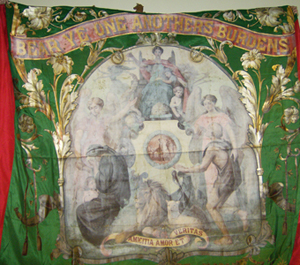 |
Court No.2585 Banner - Reverse
As with the front, the quality and condition of the painted image is faded, although the silk surround is not bad. The red edging might best be described as fragile. |
|
| Back to Top | ||
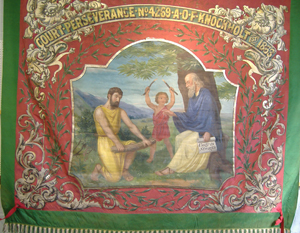 |
Court No.4269 Banner - Front Court “Harrow”, No. 4269 was established in the Kent village of Knockholt at the Harrow Inn in late 1863. A constituent member of the London United District, by the end of the century it had 146 members, and had changed names. It became Court “Perseverance” in 1886, so that clearly the banner, whch bears that name, dates from after the change. The Court remained in existence until 1996 when it amalgamated with Court “West Kent”, no. 3420. An unusual front, in that in place of the standard Foresters’ Arms, the image shows a man attempting to break a bundle of sticks, watched by an elderly, presumably wise, man holding a parchment with the words ‘Unity is strength’ on it. Behind is a child who has successfully broken a single stick. All elements of this banner are in reasonable condition, although there is evidence of some repair work to the centrally painted image at some time. |
|
| Back to Top | ||
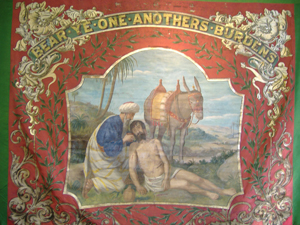 |
Court No.4269 Banner - Reverse The reverse of the banner from Court “Perseverance”, No. 4269 at Knockholt shows the biblical parable of the Good Samaritan. The superscription reads ‘Bear ye one anothers burdens.’ The central image is in a good, but repaired state, with some old stitching binding a crack in the paintwork. The image, neverthess, is clear and the colours remarkable for their age. The silk surround is in fine condition and the banner still has green edging, although whether or not this is original is hard to tell. |
|
| Back to Top | ||
 |
Court No.3095 Banner - Front Inhabitants of Billericay in Essex embraced the AOF in 1858 when a Dispensation was granted for a Court to be established at the Sun in the High Street, where William Abbott Piper was the landlord. The reason for the name members chose for the Court, “Rubens” is not immediately obvious, but no doubt it had some significance to them. The Court joined the ranks of those connected with the ever increasing London United District. Membership of Court ”Rubens” was clearly valued, and by 1900, there were some 635 adult benefit members. Noticeably the average age of members was 35, substantially lower than many other Courts formed at the same time, suggesting that it continued to attract the young men of the area. The banner is a remarkably good state of preservation, with, on the front, both the central image, of the Foresters coat of arms with two male Supporters, and the surrounding silk in excellent condition. |
|
| Back to Top | ||
 |
Court No.3095 Banner - Reverse The caring culture of the Foresters’ is reflected on the reverse side of Court “Rubens” banner. The central image shows the sick visitor, or as called in the AOF, the Woodward, undertaking one of his primary duties, that of visiting sick members. The purpose was twofold. On the one hand there was the financial aspect, with the Woodward passing over the sick pay entitlement. On the other was fraternal aspect, the sharing of experience that made the Foresters, and other friendly societies, such a valuable part of a hard, and otherwise indifferent, world. Court “Rubens” Woodward had his hands full following the 1914-18 War. In 1920 the Court had 780 members, with a recorded number of sick days to be paid for reaching 8,889. The Secretary was even busier, as he had in addition to voluntary members, some 645 State members, under the 1911 National Insurance Act to deal with. Court “Rubens” ceased to exist as an independent Court in 1999, when it amalgamated with Court “Princess Alexandra”, No. 4163. |
|
| Back to Top | ||
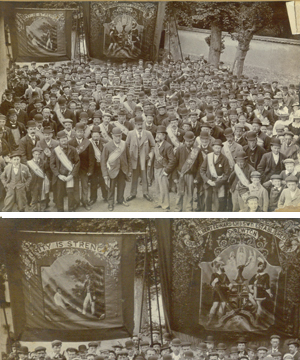 |
Court No.6369 Banners on Parade This assembly of Foresters at Shrewton in Wiltshire is undated but, by appearances, looks to be c.1910. Two banners are in evidence, with the one on the right that of AOF Court “Alfred Edward”, No. 6369, named after Queen Victoria’s eldest son. The reason is obscure, the Court being founded in 1877. The letters SWD indicate the Court’s membership of the extensive South Western District of the AOF. At the period the photo was taken, members were meeting in the National School, so that it is possible this view shows them gathering in the school playground. The number of men shown in the picture has not been counted but it is known that membership of the Court around 1910 stood at just over 200. The Court did not have any Honorary Members so it is a bit of a mystery as to who the prominent, and prepossessing, central figure lacking a sash or ribbon, might be. The second banner, with the motto Unity is strength may be another banner belonging to the Court, or to another organisation involved in the assembly. Court “Alfred Edward”, No 6369 amalgamated at the beginning of the 21st century. |
|
| Back to Top | ||
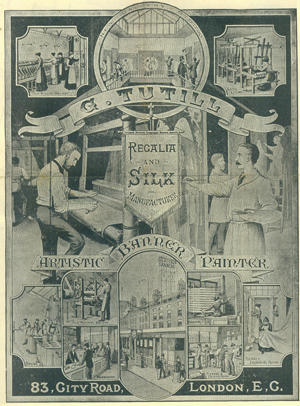 |
G Tutill - Regalia Manufacturer George Tutill was one of the most successful businessmen engaged in meeting the needs of, amongst others, friendly society Orders, including the AOF. Born in Howden, in the East Riding of Yorkshire, he came to London in the late 1830’s. He regularly described himself as an artist or painter, hence his involvement with particularly the production of banners. He was a prominent Forester on the London scene in the 1840’s and 50’s, serving as the initial District Chief Ranger (Chairman) of the City of London District, and had membership of various Courts. Eventually he settled on Court “Industry”, No. 1752 and represented fellow members at the annual High Court Meetings of the Order for a number of years. His manufacturing premises and shop were, from around 1859, at 83 City Road, London EC, just outside the city walls. In these views, the processes associated with banner production are shown. It was, evidently, a labour intensive activity, involving skilled workmen and women in a number of areas. At the end of all their endeavours, finished banners were sold according to size. At the top end of the range, a Patent India Rubber Silk Banner, 12ft by 10ft 6ins (3.6m x 3.15m), cost 24 guineas (£25.20p). For half a crown more (12.5p), ‘Two Poles. Brass Knobs, and Fittings, Straps, and Sockets, complete’ were available. |
|
| Back to Top |